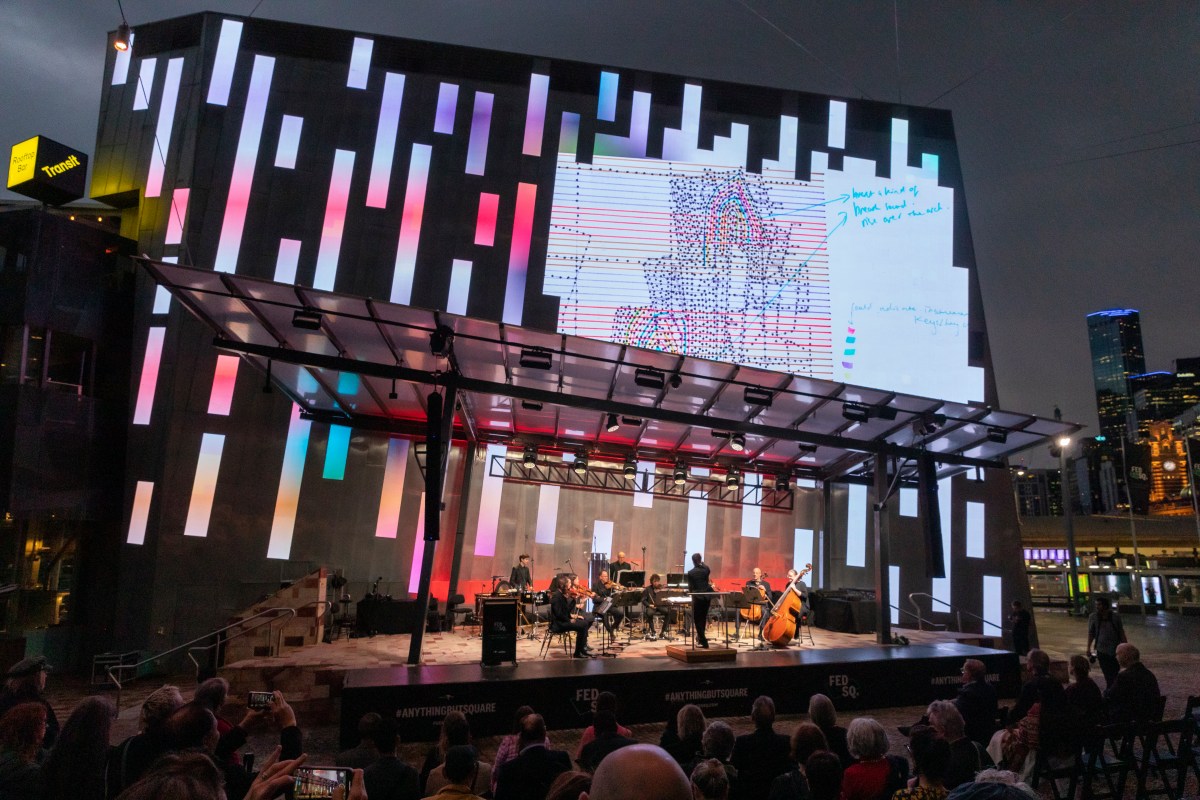Fed Square (as Federation Square is affectionately known) opened on 26 October 2002. Twenty years later, on 26 October 2022, two works celebrated this significant moment in Melbourne’s history. Launched by the ABC’s Jon Faine, whose address emphasised possibility and connection, the two works were A Score For Fed Square by Mia Salsjö and performed by members of the Melbourne Symphony Orchestra, and Sun Songs, by sonic artists J David Franzke and Geoffrey Nees, with lighting design by Ben Cobham.
Fed Square opened as Melbourne’s gathering space and city centre, but the significance of the site began long, long ago. It’s the place where Victoria’s Indigenous tribe would gather for their own federations. The Wathaurung, the Bunurong and the Woiwurung peoples (that include Melbourne’s Wurundjeri tribe), gathered and camped in the space by the river for tens of thousands of years. When they were dispossessed of their land, the site became variously a morgue, a fish market, a railway yard and a series of office blocks.
In 1996 the Victorian State Government opened an international competition to design a space for the heart of Melbourne. It was won by then London-based LAB Architecture Studio, which partnered with Melbourne firm Bates Smart to produce a design that emphasised federation, the shared perspective of many different angles and the meeting of different cultures. As an aesthetic, this was at times controversial.
The two commissioned pieces illustrated the haunted past of Federation Square as well as the potential of the site as a place of meeting and connection.
Salsjö’s A Score For Fed Square was performed first, with a charming introduction by the artist herself. She described how the piece was inspired equally by her grandfathers, a street sweeper and a composer, and talked of sitting at the piano with her ‘fafa’ as he taught her to play.
Salsjö’s work is a world away from the melodic music of the Swedish 20th century though. She has made a name for herself by composing contemporary works that use architectural plans as the basis for unique rhythms and time signatures, like her recent piece at Gertrude Glasshouse.
A Score For Fed Square had a more varied palette due to there being more instruments at play in the Melbourne Symphony Orchestra, but the textures were basically the same. The piece’s percussive rhythms invoked an Indigenous corroboree. Syncopated rhythms with discordant resonances gave way to mournful minor melodies dominated by strings. Images of the plans for Fed Square as well as Salsjö’s own notes offered a meta-history of the piece, even as the work itself reflected Fed Square’s many-sided history.
Sun Songs, meanwhile, looked more to the natural world and the optimism of the future, while acknowledging the legacies of the past. The concept was a sound and light ‘bath’ that played in Federation Square at both sunrise and sunset, and featured futuristic electronica that consolidated into jazz-like riffs, with a whistle-like sound inspired by the call of local birds. The lighting element was timed to respond to the existing rhythms of the square. Sun Songs was conceived towards the end of lockdown to revitalise the meeting place with a celebration of community.
Read: Book review: Salonika Burning, Gail Jones
Both pieces referred to Fed Square’s many faces as a meeting point of culture. They illustrated the history and the future of public art in the city of Melbourne.
A Song for Fed Square and Sun Songs were both performed on 26 October 2022.





